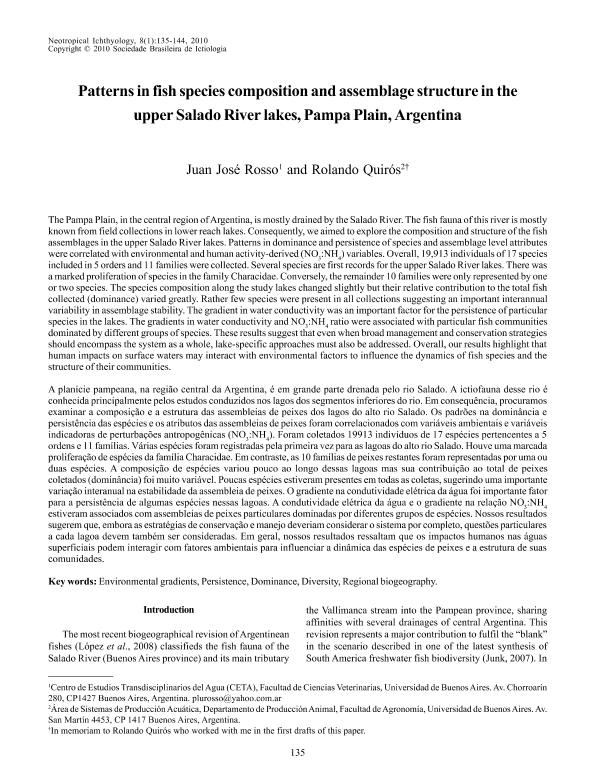Mostrar el registro sencillo del ítem
dc.contributor.author
Rosso, Juan Jose

dc.contributor.author
Quiros, Rolando

dc.date.available
2017-05-15T21:10:30Z
dc.date.issued
2010
dc.identifier.citation
Rosso, Juan Jose; Quiros, Rolando; Patterns in fish species composition and assemblage structure in the upper Salado River lakes, Pampa Plain, Argentina; Sociedade Brasileira de Ictiologia; Neotropical Ichthyology; 8; 1; -1-2010; 135-144
dc.identifier.issn
1679-6225
dc.identifier.uri
http://hdl.handle.net/11336/16515
dc.description.abstract
The Pampa Plain, in the central region of Argentina, is mostly drained by the Salado River. The fish fauna of this river is mostly known from field collections in lower reach lakes. Consequently, we aimed to explore the composition and structure of the fish assemblages in the upper Salado River lakes. Patterns in dominance and persistence of species and assemblage level attributes were correlated with environmental and human activity-derived (NO3 :NH4 ) variables. Overall, 19,913 individuals of 17 species included in 5 orders and 11 families were collected. Several species are first records for the upper Salado River lakes. There was a marked proliferation of species in the family Characidae. Conversely, the remainder 10 families were only represented by one or two species. The species composition along the study lakes changed slightly but their relative contribution to the total fish collected (dominance) varied greatly. Rather few species were present in all collections suggesting an important interannual variability in assemblage stability. The gradient in water conductivity was an important factor for the persistence of particular species in the lakes. The gradients in water conductivity and NO3 :NH4 ratio were associated with particular fish communities dominated by different groups of species. These results suggest that even when broad management and conservation strategies should encompass the system as a whole, lake-specific approaches must also be addressed. Overall, our results highlight that human impacts on surface waters may interact with environmental factors to influence the dynamics of fish species and the structure of their communities.
dc.format
application/pdf
dc.language.iso
eng
dc.publisher
Sociedade Brasileira de Ictiologia

dc.rights
info:eu-repo/semantics/openAccess
dc.rights.uri
https://creativecommons.org/licenses/by-nc-sa/2.5/ar/
dc.subject
Environmental Gradients
dc.subject
Persistence
dc.subject
Dominance
dc.subject
Diversity
dc.subject
Regional Biogeography
dc.subject.classification
Ciencias Medioambientales

dc.subject.classification
Ciencias de la Tierra y relacionadas con el Medio Ambiente

dc.subject.classification
CIENCIAS NATURALES Y EXACTAS

dc.title
Patterns in fish species composition and assemblage structure in the upper Salado River lakes, Pampa Plain, Argentina
dc.type
info:eu-repo/semantics/article
dc.type
info:ar-repo/semantics/artículo
dc.type
info:eu-repo/semantics/publishedVersion
dc.date.updated
2017-05-08T21:19:52Z
dc.identifier.eissn
1982-0224
dc.journal.volume
8
dc.journal.number
1
dc.journal.pagination
135-144
dc.journal.pais
Brasil

dc.journal.ciudad
Porto Alegre
dc.description.fil
Fil: Rosso, Juan Jose. Universidad de Buenos Aires. Facultad de Ciencias Veterinarias. Centro de Estudios Transdisciplinarios del Agua; Argentina. Consejo Nacional de Investigaciones Científicas y Técnicas; Argentina
dc.description.fil
Fil: Quiros, Rolando. Universidad de Buenos Aires. Facultad de Agronomia. Departamento de Producción Animal. Cátedra de Sistemas de Producción Acuatica; Argentina. Consejo Nacional de Investigaciones Científicas y Técnicas; Argentina
dc.journal.title
Neotropical Ichthyology
dc.relation.alternativeid
info:eu-repo/semantics/altIdentifier/doi/http://dx.doi.org/10.1590/S1679-62252010005000007
dc.relation.alternativeid
info:eu-repo/semantics/altIdentifier/url/http://ref.scielo.org/7jvydr
Archivos asociados
